Editor’s Introductory Note: This article (in shorter draft form) was originally posted in 2016 at Survivalistboards.com, and is posted with the author’s permission. (He retained his copyright.)
Author’s Introductory Caveat: Some government authorities may not allow living like this. It worked for us in Montana but then we chose to not seek permission from them.
—
Our first Montana winter was spent in an 8′ x 10′ shelter. We survived. And yes, we are still married.
This article is directed toward folks who:
- Live far from where they would like to establish a bug-out, and
- May want to eventually move to theirBug Out Location (BOL) and begin building their future homestead.
SUMMARY
This article suggests buying land for a future homestead. Initially a CONEX shipping container can be placed on the property. It can immediately serve as a reasonably secure, pre-positioned, pre-provisioned Bugout shelter. It can be used for camping vacations. These can be great opportunities to get to know neighbors, find local resources, get a head start on site improvement such as clearing, access improvements, installation of electric (grid or solar) etc.
If the SHTF, folks basically just need to get themselves to their BOL. When the time comes to permanently relocate, the shelter can serve as temporary housing and construction office. After moving into their homestead, they will haves a valuable BO shelter set up on the property and immediately available for use by loved ones.
OUR STORY
We are retirees (husband an engineer, wife a math teacher) who chose to move to the American Redoubt (Montana) largely based on the recommendations of James Wesley, Rawles and Joel Skousen. We owe a debt of gratitude to both gentlemen.
Initially we rented in town while taking our time to get to know the area, meet like-minded people and search for property. The search took a year. We finally found a very rural 10 acre wood lot in Montana. It is located on a long dead-end private road. It has two precious springs running through it. The only signs of man on the property was a very old but well-built stone-lined outhouse. While the location is fairly remote, electric and telephone were available at our lot. The area has many families living off-grid and/or homeschooling their children. Both are strong indicators that you have found a good BOL. The Icing on the cake was that our nearest neighbors were good friends from church.
Initially we cleared for the future building site and driveway. We purchased a 20 ft. CONEX shipping container affectionately to be known as ‘The Cabin’ and located it in a wooded area near our future homestead.
For several years we used our Cabin for camping, practicing bug-out and testing our preps in real world conditions.
By the summer of 2014 we got serious and prepared to move to The Cabin before winter set in. We graveled the driveway and installed underground electric to the future building site.
On December 1st we moved from our in-town apartment to The Cabin. What a winter! What a great feeling to be hunkered down! We survived. And yes, we are still happily married! Okay, I must admit that my wife is a trooper.
Winter was tough but made easier by not having to travel except for hot showers at a local RV campground. We managed to build a 12 ft. x 16 ft. wood shed and fill it with firewood worked up from logs cleared from the site. We paced ourselves (since I was well into my 70s) but at the end of each day we knew we would be warm, dry and well fed back in our cozy little ‘Cabin’. By spring we were ready to begin construction of our homestead. Halleluiah!
Looking back, we honestly have fond memories of that first Montana winter in our cozy little ‘Cabin’. And now it gives us comfort knowing that if the SHTF, our little ‘Cabin’ is right out back, ready and able to provide shelter for loved ones. Of course the grandkids take it over when they come to visit.
CONSTRUCTION
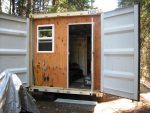 We left the rear half open for cold storage and partitioned (2x4s walls and ceiling with R-13 fiberglas insulation and 6-mil poly vapor barrier on warm side) the front half for living space. That’s only 80 sq. ft. but it was warm, dry and cozy. The floor was insulated with 1” Dow Styrofoam R5 rigid insulation (aka ‘blue board’). Surprisingly, it held up to the foot traffic reasonably well. (see ‘Things We Would Do Differently’). Light was important so we placed a storm door with lots of glass for our exterior door. It was single-pane glass. Yes, it frosted up and we occasionally had to chip ice so that it would close properly. No big deal. The interior door to the cold ‘back room’ was just an el-cheapo interior door. We added a ‘sweep’ to the bottom, making it quite draft-free. Rigid insulation attached to the cold side kept the door warm and eliminated any frosting problem. From inside The Cabin, both doors swung ‘out’ so as to not interfere with the 1” blue board on the floor.
We left the rear half open for cold storage and partitioned (2x4s walls and ceiling with R-13 fiberglas insulation and 6-mil poly vapor barrier on warm side) the front half for living space. That’s only 80 sq. ft. but it was warm, dry and cozy. The floor was insulated with 1” Dow Styrofoam R5 rigid insulation (aka ‘blue board’). Surprisingly, it held up to the foot traffic reasonably well. (see ‘Things We Would Do Differently’). Light was important so we placed a storm door with lots of glass for our exterior door. It was single-pane glass. Yes, it frosted up and we occasionally had to chip ice so that it would close properly. No big deal. The interior door to the cold ‘back room’ was just an el-cheapo interior door. We added a ‘sweep’ to the bottom, making it quite draft-free. Rigid insulation attached to the cold side kept the door warm and eliminated any frosting problem. From inside The Cabin, both doors swung ‘out’ so as to not interfere with the 1” blue board on the floor.
HEATING
We initially used a Mr. Heater Buddy Portable 4,000–9,000 BTU propane heater for camping but it was too big. Then we switched to a Coleman SportCat PerfecTemp Catalytic Heater which put out 1,500 BTU and ran 12 hours on a 16.4 oz. propane cylinder. It worked fine for outdoor temps down to 35F. Both used small 16.4 oz. cylinders. We refilled these from a 20 lb. propane tank using a Mr. Heater F276172 Propane Tank Refill Adapter ($15). Tank costs dropped to about $1.00 per 16.4 oz. cylinder.
The biggest problem using the non-electric propane heater was ‘stratification’ of heat. Translation: ‘hot air rises’. The floor area was very cool while the ceiling area was very warm. Having to keep the window slightly open for ventilation compounded the effect. By Christmas we finished the 20 amp feed to The Cabin. Wow, what a difference! We plugged in a small fan-forced 1500 watt portable electric heater. It had 3 heat settings: 500, 1,000 and 1,500 watts. Temps plunged to 18F below zero on the coldest night. We were toasty warm with the heater set to medium 1,000 watts. The fan also solved the temperature ‘stratification’ problem.
COOLING
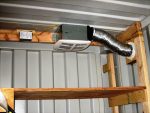 Summer nights got uncomfortably warm. Even though we selected a light colored CONEX shipping container the metal ceiling got hot. (Yes, even in Montana). We painted the roof exterior with two coats of white Black Jack elastomeric reflective roof coating. This alone lowered the temperature highs by 10F. Installation of an exhaust fan also helped in summer cooling (see ‘Things We Would Do Differently’).
Summer nights got uncomfortably warm. Even though we selected a light colored CONEX shipping container the metal ceiling got hot. (Yes, even in Montana). We painted the roof exterior with two coats of white Black Jack elastomeric reflective roof coating. This alone lowered the temperature highs by 10F. Installation of an exhaust fan also helped in summer cooling (see ‘Things We Would Do Differently’).
USE OF PROPANE
Ventilation is important but it is basically proportional to BTU output. Very little was required for a 9,000 BTU Mr. Heater. Quoting the owner’s manual, “This heater requires a vent area of 9 square inches (example 3” x 3” opening.)” We lost little heat providing the required ventilation.
The other manufacturer warning is that if you choose to use a 20 lb. propane tank for any device it must be located outdoors.
We installed both fire/smoke and carbon monoxide alarms in The Cabin. That was money well spent.
ELECTRIC
For several years we used a portable Honda 2000 inverter generator (very dependable, quiet and gas stingy) to run work tools. It could also power The Cabin which was wired conventionally for lights and receptacles. The entrance feed was a 12/2 W/G yellow extension cable through the outside plywood wall (see yellow cable in picture). We could simply plug the cable into the generator.
We were prepared to live off-grid but ‘The Game Changer’ came just before Christmas 2014. We had already moved into The Cabin for the winter. Suddenly we had 20 amps 24/7! We were living large!
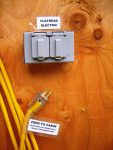 An electric meter and very small circuit breaker box were mounted on a 6×6 pressure treated post 50 ft. from our future homestead. This box served only a double duplex receptacle at the post for construction tools and the 12/2 WG underground feed to The Cabin. (Ultimately a 200A circuit breaker panel was installed in our homestead.) The 12/2 W/G underground cable was terminated in a receptacle (labelled ‘Flathead Electric’ — referring to our local power co-op) mounted on the outside plywood wall. We left the yellow extension cable entrance feed as is and could simply plug it into the receptacle or the generator. ‘Simple’ is good! Everything was mounted on the outside plywood wall allowing the shipping container doors to be closed when not in use.
An electric meter and very small circuit breaker box were mounted on a 6×6 pressure treated post 50 ft. from our future homestead. This box served only a double duplex receptacle at the post for construction tools and the 12/2 WG underground feed to The Cabin. (Ultimately a 200A circuit breaker panel was installed in our homestead.) The 12/2 W/G underground cable was terminated in a receptacle (labelled ‘Flathead Electric’ — referring to our local power co-op) mounted on the outside plywood wall. We left the yellow extension cable entrance feed as is and could simply plug it into the receptacle or the generator. ‘Simple’ is good! Everything was mounted on the outside plywood wall allowing the shipping container doors to be closed when not in use.
WATER
The springs were good for most water needs. For drinking water, we filled jugs at the local RV campground.
SANITATION
We had the existing outhouse and also a porta-pottie in the unheated ‘back room’. We used windshield wash (good to -20F) instead of water. Waste was emptied into the outhouse pit.
Gray water was piped into a bed of crushed rock below ground (see opening caveat). That said, our lifestyle was ‘greener’ than any conventional home today.
HYGIENE
The local RV campground offered public showers for $5. That worked for us. They also offered free Wi-Fi so we could stay in touch with the outside world. ‘Free’ is right in the middle of our price range.
VENTILATION
I cannot overemphasize the importance of an airtight poly vapor barrier on the inside walls. Still, some vapor will seep through, hit the frigid metal shipping container and B-I-N-G-O! you have frost. Frost in itself is no problem, that is, until outdoor temps rise above 32F. All unheated spaces must be vented to the outside. (See: ‘Things We Would Do Differently)
Moisture within the heated living area was no problem and easily controlled by window ventilation.
SECURITY
When in use, we chained the open door of the shipping container to a tree and locked the chain in place so that no one could lock us in. Our dog would have alerted us to any movement of the chain.
When not in use, the shipping container’s exterior doors can be closed and locked to make it as secure as originally built and appear no different than any other container.
COST
In this area of the Pacific Northwest a like-new 20 ft. ‘one tripper’ (One made in China and with just one trip to a west coast port) costs about $4,100 including delivery/set up within a 20 mile radius). Converting ours to the Cabin added another $1,600.
The 40 ft. CONEX containers are not much more expensive. The downside to them is that there are many locations where you just don’t have the open space to maneuver them into place. Also they required much heavier equipment to move. Otherwise they are a great value.
THINGS WE WOULD DO DIFFERENTLY
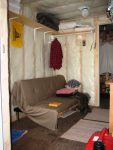 Our biggest problem was ice and humidity build-up in the unheated rear half of the container. We ultimately solved the problem with two wall vents (approx. 144” sq. inches each) with insect screens connected to a Broan 784 80 CFM Exhaust Fan ($50) controlled by a Ventamatic XXDUOSTAT Adjustable Dual Thermostat/Humidistat Control for Power Attic Ventilators ($47). The exterior walls were surprisingly easy to cut using a 4-1/2 inch angle grinder.
Our biggest problem was ice and humidity build-up in the unheated rear half of the container. We ultimately solved the problem with two wall vents (approx. 144” sq. inches each) with insect screens connected to a Broan 784 80 CFM Exhaust Fan ($50) controlled by a Ventamatic XXDUOSTAT Adjustable Dual Thermostat/Humidistat Control for Power Attic Ventilators ($47). The exterior walls were surprisingly easy to cut using a 4-1/2 inch angle grinder.
In retrospect we would frame/insulate the whole interior of 20 ft. container. This would eliminate the interior door and drastically reduce the moisture escaping into unheated space. We would still install two wall vents (approx. 144” sq. inches each) at the rear of The Cabin. We would still install the exhaust fan controlled by a thermostat/humidistat. The equipment would be located between the framed walls/ceiling and metal container with an access panel inside The Cabin. The poly vapor barrier would still be absolutely critical. Make it as airtight as possible.
Lastly, rather than place 1” Dow Styrofoam (aka ‘blue board’) R5 insulation on the floor, spraying the underneath with a couple inches of closed cell urethane (R10) would make a professional job.
ABOUT CONEX CONTAINERS
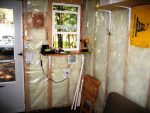 CONEX shipping containers offer some unique benefits: Portability. Minimum maintenance. Some ballistic protection. Decent security. In upgrading to our Cabin we did nothing to adversely affect these benefits. When not in use The Cabin appeared like any other container. While we had no intention to move The Cabin it is comforting to know that in a couple hours it could be made ready to move to another location. You never know what tomorrow will bring.
CONEX shipping containers offer some unique benefits: Portability. Minimum maintenance. Some ballistic protection. Decent security. In upgrading to our Cabin we did nothing to adversely affect these benefits. When not in use The Cabin appeared like any other container. While we had no intention to move The Cabin it is comforting to know that in a couple hours it could be made ready to move to another location. You never know what tomorrow will bring.
Lastly, this engineer would be remiss to not plead with folks contemplating shipping containers: Please don’t try to bury them. ‘Nuff said.
We hope this gives some helpful ideas to folks. Carry on.
– Montana Guy, Annie Oakley, and Shotgun (Arf-arf!)

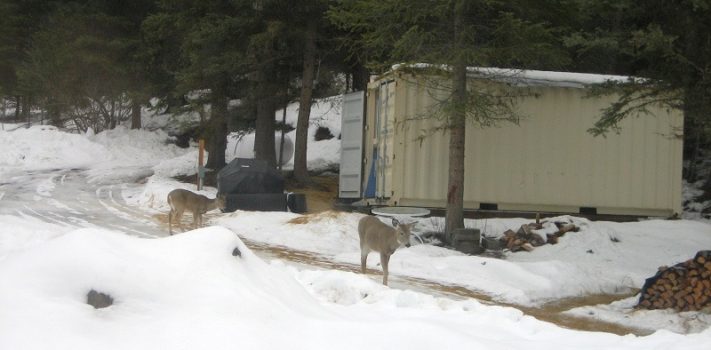









Informative article sir. I too live under the umbrella of Flathead Electric. You inspire a young 40 year old guy like me to get my butt in gear.
Having worked as a civilian for the US Army, I have lived in my fair share of shipping containers. In Bosnia, during the summer heat we would all stack used tires on the roof of the container, to insulate the direct sunlight from landing on the container. After a brisk summertime rain, this also added to a cooling affect as well. Later in Kuwiat, a 12 volt solar panel and two car batteries provided immense heat relief when attached to 2 5vdc computer fans drawing air out through the top back vents, which not every container has.
The ultimate king of containers is definately the 40 foot with additional side loading doors. The end doors are entrance, and windows, and the 2 side access doors allow for an outward folding deck and roof, as well as allowing circulation.
And the best thing about living in a container inside a big storage yard…….. not even the commander really knows you aren’t in the GP medium tent, as with the doors closed during the day, it is great camoflauge. Until you come back one day to find that all the containers were shipped back to Germany, including yours.
I second the 2nd roofing panels on tires thoughts. Not only does this space help insulate from heat in summer (especially in the South and desert), it protects the top side from water rusting out the top from leaves which stay there. Wire mesh to prevent rodents and larger animals like squirrels and raccoons, from making a nest . Placing this conex unit on railroad ties to level and keep off of grade, on a pad of caliche would help elevate the floor to keep from ground water infiltration. If this installation is to be fixed for the duration, vertical concrete pier tubes can be installed for higher, more permanent support.
We don’t live in it, but my wife and I have a small 8×8 box for storing landscaping equipment and other materials at our rural pasture. We did the timber and caliche bed and can recommend it highly.
I buried mine 10 years ago and it is still doing fine in a very dry environment with good drainage away from the area on all sides. I use it as a cellar and have not tried living in it. The entrance is a walk door to a set of steps with a 3 sides shed built over the top so that rain and snow does not penetrate from that direction.
We used one for temp storage at our “place” while building. Worked great and when we were complete, we didn’t need it any longer and sold it, recovering about 80% of the cost. Interestingly the guy who bought it from us rigged some axles and wheels under it and towed it to his “place” with his tractor. I’m sure that would only be possible in a rural area… These are much easier to secure than a shed style cabin.
From time to time I’ve wondered about using multiple CONEXes in a cluster; configured as “spokes of a wheel” around a covered common area, each CONEX insulated and wired, they could serve as bedrooms, kitchen, bathroom, office, etc. Certainly not as comfortable as standard construction housing, at roughly $6-7K per CONEX (purchase, delivery, set-up, insulating, outfitting, etc.) a 4-CONEX cluster = about $25-30K and would provide “greater than spartan” accommodations while building a retreat, and could be re-configured into “guest quarters” for the future. I could easily envision four externally-insulated 20-footers connected to a 40-footer in an “H” configuration, using the 40-footer as the common area, “roofing over” the space between the 20s with a tarp over 2X6s providing “patio space,” room for storage or space for utility equipment for that pair of 20s.
I have thought about setting up 4 of them in a square, so there is an interior outdoor space. You would have a set up that is 40 by 40 on the exterior if you put them end to the side of the end of the next. The enclosed exterior space could be for gardening, trees, patio, and many more possibilities.
A person I worked with had a similar set up for a deer hunting camp in the deep south. He had a similar generator and a 5,000 watt generator. He also used it for a hurricane evacuation shelter. His family was “living large” while the power grid was down for 4 weeks in August. Temps were 95 degrees F all day. The air conditioner run time was about 20 minutes of every hour.
They do make an insulation kit for Conex Container’s. Look up container houses on the internet. If one wants to bury them you need to reinforce it in the top inside and the side walls inside. And when you back fill push your fill no more than 2 ft. all the way around your container at a time. If you try and push it all on one side you may push your side’s in.
Good luck. The Gman
We converted a small Conex insulated it and cutout for a window AC its makes the perfect meat locker for Elk and deer.
Hmmmmmmm, I am wondering about a shed built on a mobile home frame. Or even a small trailer frame. Relatively inexpensive and should be able to be sold and moved and recouping most of your initial expense.
Food for thought
Folks have many options depending on their situation and needs. Our criteria included: portability, minimum maintenance, some ballistic protection, decent security (when left unattended). Lastly, when we got done we wanted the CONEX to retain all of its original inherent features and benefits.
We seriously considered a shed. Once the homestead was built a shed would be a more comfortable ‘guest shelter’ than the CONEX. But the CONEX better met our criteria. A shed ‘way out there’ would have given me some restless nights during the initial long periods when it was left unattended.
Bagman501: Be sure to consider weight. 2×4 stud construction is significantly heavier than travel trailer construction.
Next to our log home a gentleman put up a CONEX shipping container and was an eye-sore. We talked brefly and I handed him an Amish Shed-Company brochure. These Amish sheds are all over Montana in open lots and seen from highway drive-byes.
Long story short, he sold the shipping container and added two of those sheds that look like mini-houses. He even paid a few extra bucks had it insulated and wired to code and plumbed. Set them on his property.
The eye-sore was gone and it was much cheaper in the long run to have a nice looking cheap mini-house already fitted for living than building out their own CONEX Zombie Apocalypse shipping container.
Nice article, all-in-all. One thing taken away as it is a labor of love, homesteading. You’ll never really be done and always have something to do. GOOD NEWS… is you have freedom to continue to do what you want on your own property instead of CCRs from some associating like in a residential neighborhood.
All the best!
I am not a snob but this will sound like it. I dislike the ubiquitous conex containers and consider them an eyesore. They may be somewhat secure and functional but are seldom maintained and may be difficult to remove. I say this because I made an offer on a small desert property contingent on the seller moving two containers. His answer was no …. can’t find anyone to move it …. move it yourself. (No price adjustment ….. No sale).
I also think the conex containers will someday be compared to the scourge of dilapidated trailer houses that visually ruin the landscape all across beautiful America. They deteriorate with age unlike a wooden structure that dies gracefully.
Of course, opinions are like ass*****; every body’s got one. But I agree that a nice wooden structure looks better. And a frame cabin would be easier to heat and make comfortable. It should be cheaper if owner built.
I hear you. Having served (reluctantly) on a zoning board I appreciate the benefits of ‘fitting in’ with your neighborhood. That’s one reason we moved to the mountains. Heck most folks here can’t even see their neighbors. We enjoy the liberty-loving mind-your-own-business mindset. Don’t get me wrong. If you need help they would be right there. But honestly, if any of them could see the Cabin I can’t imagine anyone getting their panties in a wad over the looks it.
“is you have freedom to continue to do what you want on your own property instead of CCRs from some associating like in a residential neighborhood.”
Apparently not, if you have a whining neighbor complaining about an eyesore.
True liberty: if it’s not on your property, it’s none of your business.
Instead of all that work fixing up that Conex, what about just buying either a trailer or a used single-wide mobile?
I thought of that too, but if you want to burn wood for heat, easier in a Conex than a camper/trailer.
There are MANY single-wide mobile homes with a wood burning stove. Seriously, a used single-wide mobile with a wood-burning stove is good to go, whereas you have to spend all kinds of $$$ and time to adapt a Conex to livable condition. How much is a Conex? About $1,500 to $2,500 or so? You can get a used single-wide in Boise for $8-12K, all ready to go.
On a similar note: Many coal-fired power plants are shutting down. I’ve thought of using a whole container just to store coal. A temporary bulkhead with a chute or gate could be just inside the main doors. If and when coal trains derail, they use a contractor named “Hulcher Rail Services” to clean up the whole site. Perhaps they could offer a deal on some slightly dinged and dented coal.
That was quite an challenge and adventure, a story and lesson of perseverance and rugged individualism in modern garb. Despite the extreme hard ship, the determination to unplug from the Big City, and move toward a self sufficient life style, especially late in life, is inspirational.
This is to myself, is not about a converting a shipping container. It is about those who are truly prepared mentally and spiritually, who are so determined, who will endeavor to endure though out a struggle, who will pursue the safety and sanity of a remote and self sufficient life style. These persons give up the comforts of city life, will be found in regions of the country that still loves liberty. With little to nothing, even with their own aging bare hands, if that is what it would require. They have arrived, these precious lovers of Liberty, and God Almighty.
Thank you for your kind words. We old coots (me, NOT Annie Oakley) in our 70s have a blessing and perhaps a motivation to endure. We are old enough to remember what we have lost. Stay the course.
Tunnel Rabbit, I see you have been busy writing some awesome articles. Carry on!
Montana guy, I had no idea you were in your 70s. You “write young” in my opinion. I’ll bet I would enjoy walking the woods and chatting with you.
Carry on
Thank you for that encouragement. I am not that far behind you.
If I am in your area and could help, let me know. tunnelrabbit007@gmail.com
Thank you Tunnel Rabbit. Keep emphasizing communications like you have been. It seems like the stepchild of preppers and the weakest and often missing link.
Like most newbies Annie Oakley and I struggled ramping up. We needed a little ‘hand holding’ using OUR RADIOS. AmRRON friends gave us just that. Until then having them without actually using them truly gave us a false sense of security.
I bought a “one trip” 20′ CONEX just a month ago. With the right lock (I use an American Lock Co. Series 700 – known affectionately as a riot lock (used on store gates in the South Bronx)), it is more secure than my house or my workshop. If I wanted something to live in, I’d purchase a refrigerated unit. The insulation is already built in. Many of them can be had for just a little more than the regular ones if the freezer/refrigerator is no longer working.
Ah, yes, wood structures. They look so quaint. Until a wild fire comes through and POOF! It’s gone. Conex containers bedded on gravel “pads” are off the wet earth and last a long time with minimal maintenance. Wood structures can look awful, too.
Steel doesn’t care about wildfire, termites, lightning, and they don’t fall apart like RV trailers, built with staples and glue guns.
If you can, buy the High Cube models. Build the deck about 20 inches off the floor and you have gobs of storage space under the deck and an easy pipe chase for plumbing in a bathroom and shower.
I’m not saying you can withstand a wildfire with the forest right next to you, but they do OK within about 70 feet of buring brush and Junipers…..a lot better than a nice-looking home built out of fuel. i spent the last two summers breathing all those nice California mansions that went up like firewood.
I use one for a shop, a generator room, and another for firewood storage. Friends have modified containers for backup cabins, and the raised deck seems to work splendidly.
Not recommending burying containers. Not designed for this.
Also, cut in and install steel industrial man-doors for entrances….don’t use the end doors. Pricey, but worth it. Paint your container earth tone colors, maybe your neighbors won’t complain. Mine don’t….no one can see them. 🙂
The insulated(not reefer) high cube units are preferable and not much more expensive and have normally only been used for food shipment(no worries about contamination). The use of a fitted insulated sliding glass door(order to size) would make the fittout cheaper and more comfortable(a sceen/storm door?) with better access,light,insulation. The roofing issue could be easily solved with a P/V set up that not only provides power but also shades and prevents heavy snow buildup and possible extra storage,just orient for solar power when unit delivered. For more ideas on how these can be used see the videos on how small “blue water criusing” boats are set up. Containers are also much more secure,fire resistant,economical,storm,modularly improveable and earthquake resistant than any wood cabin could hope to be.
Before using a Conex for living quarters, ensure it has not been treated with insecticides. Living in an enclosed space impregnated with arsenic and cyanide is not conducive to surviving an apocalypse or even a pleasant season in the woods.
Otherwise, they are fairly mouse/rodent proof, which is one of our prime requirements. We have 7 of them, scattered all over the ranch. All are being used for storage – at least until the “real” house gets built. We are careful not to store anything that shouldn’t be allowed to freeze or to melt. The heavy duty shelving units from Sam’s Club are a great way to keep things organized and accessible without needing to dig things out from the bottom of a stack of bins and boxes. You won’t be able to fit as much stuff into the container but you WILL be able to find and reach what you need when you need it.
As for being an eyesore… lots of properties around here have old boxcars parked out in the fields and around the barns and houses. They have been used for livestock shelters, feed storage and equipment sheds for decades. I figure the Conex is the boxcar of the 21st century, but it is more weatherproof and secure. The Conexes are more secure against rats, being mostly steel. We have 2 boxcars that were here when we bought the ranch. They have holes eaten in the sides, floors and roofs by rats. Some have been patched with wood and the patches have been eaten. The sliding doors don’t slide too well anymore, so I would never dare to call them secure from anyone, anything or any weather. On the other hand, our Conexes are kept closed, locked, and are waterproof, bug and rodent proof and dust proof as far as I can tell… and we have plenty of that around. And I have plans to paint them to match the landscape when the other, more immediate projects are completed. Or, I could paint them to look like little cottages…. hmmmm…
Once the house gets built, we can move them to less noticeable locations, maybe convert one to a greenhouse with some recycled windows and skylights. That could work…. okay, time to pull out the sketch pad.